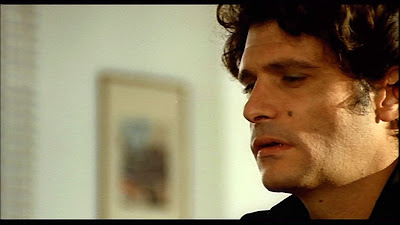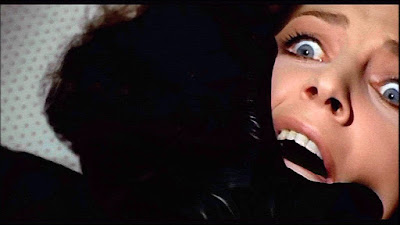Dario Argento
Four Flies on Grey Velvet
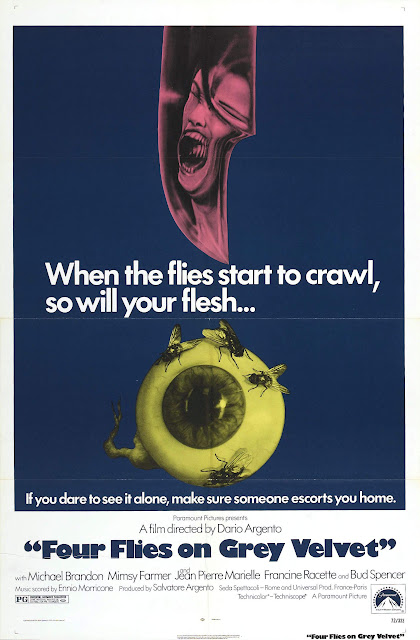
[AKA 4 mosche di velluto grigio]
This is certainly going to be the slimmest write-up of any of this week’s Argento films. I’d seen Four Flies… before but I could remember almost nothing about it, something which is very rarely a good sign!
To be fair to Argento, before I’m critical, this was only his third film as director. Following in much the same vein as Bird with the Crystal Plumage, this is a film that is far more closely linked with more traditional crime and mystery films than with the tense horror he went on to make. Four Flies… shows many early versions of what would become Argento tropes; it treads a line somewhere between murder mystery and actual horror but is always slightly unsure of where it really lies.
Several of the elements that came to be used so potently in future films - suggestions of the occult, witchcraft and magic - are present but in much more basic forms, forms which occasionally work but often don’t. By way of example, (and although I would never invest too much hope in an Argento plot), the use in Four Flies of a radical new science technique that captures exactly what the eye saw before death is not supernatural, it’s just silly. This is the kind of thing that undermines a film, especially a film of the kind Argento produces; suspension of disbelief can be carried a long way (especially when we’re enjoying ourselves!) but when something strikes the viewer as being silly, all tension is lost.
This is, much like the other criticism/faint praise this week, not to suggest that Four Flies is a bad film. It’s not. It’s enjoyable, it has a couple of good murders in it. It leaves you guessing for much of its duration. It is not, however, a great film. It is, to my mind, a far cry from the ‘classic’ Argento and, although we might excuse it for being a formative exercise in style, it doesn’t stand on its own legs as a powerful or memorable film. One to watch in a spare moment but, if you’ve never seen an Argento film, not a great place to start.
Phenomena
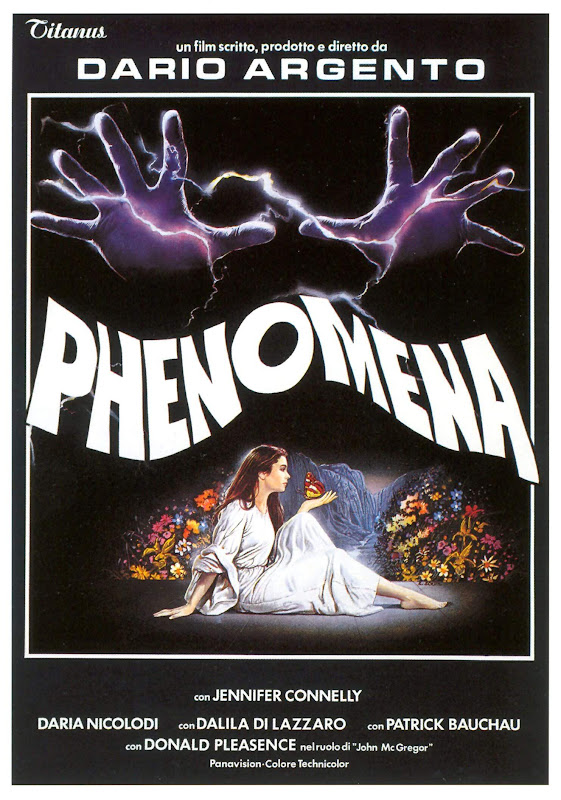
Another new (to me) Argento film, another next-day post. The problem this time, though, is that I still don’t know what to think. Phenomena has me confused; it could either be my least favourite Argento film yet or it could even be - whisper it- my favourite. I certainly will need to see it again beofre I’m sure.
It has all the faults you could accuse an Argento film of, and it has them by the bucketfull. The story is pretty much nonsensical. The dialogue is clumsy. The acting is as wooden as it gets. If I wanted (and several IMDB reviewers have wanted to) I could make this sound like a truly awful film. It’s about a half-mad girl who communicates with insects, for heaven’s sake!
So… it’s a bad film right?
Wrong.
Phenomena is, as with so many of these films, not really meant to be a narrative to follow, a dramatic performance to astound or a literary tour-de-force. It’s an experience. It’s a film you have to sit and give your full attention to. So surrender your art-critic pretensions and just immerse yourself in it. There’s a lot to like!
She does, after all, communciate with insects! This, predictably, does not mean talking to ladybirds but rather invokes biblical-plagues of flying terrors, ready to sting, nibble and smother anything in their way.
It also has Donald Pleasence (always a good thing) and a monkey.
And…
Welll…..
If I seem to be struggling to find useful things to say about this film it’s really only because it has such an absolutely brilliant, arresting, throat-grabbing, mind-boggling wonder of an ending. The film was good, sure, but the last quarter of an hour or so utterly trumped it. It’s not frightening as such (there’s certainly no scene to equal the dog-chases-girl in Tenebrae) but it is tense, it is shocking and it is delivered with enthusiasm and panache!
It would be such a shame to spoil it for anyone who hasn’t seen it, so I’ll carefully guard my tonguer (er… keys?) and leave you with a very unsatisfactorary conclusion. Phenomena is quite possibly utter rubbish with a chilling ending. Or it is quite possibly a stunning film that needs to be experienced. I’m just not sure.
Either way, I certainly need and want to watch it again.
Tenebrae (pt II)

It it, I’d say, quite fitting that Tenebrae, as the first Argento film of the week that I hadn’t previously seen, is the first that I write about with a little more space to reflect on it. And yet… still, I just don’t quite know what to make of it. Was it absolutely stunning? Was it run-of-the-mill? Was it powerful and tense? Or was it just a bit silly?
As I was watching the film - up to about 2/3 of the way through, at least - I was none too taken in by it. It seemed pretty much your typical slasher. As per usual, it was shot beautifully, as per usual the deaths were gleefully brutal but… there really didn’t seem an awful lot that marked it out from the crowded field. It has people being killed. It has ransom-note style anonymous letters. The lead character just happened to be in Italy at the time (this seems to be quite an Argento trope…). Mysterious phone-calls! Someone wearing a mask! The basic plot elements are all just a little too… average.
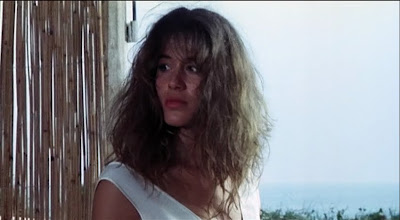
But this is Argento! So perhaps it was unreasonable of me to be concentrating too hard on the plot, after all. Again, however, I found myself feeling disappointed. Although there were a handful of interesting camera angles I felt like something was missing; why wasn’t the camera taking such an excitingly active role as in some of the others? In this, I must now admit, I was just plain wrong. The camera work in Tenebrae is fabulous. It does half of the same things as in his other films but - crucially - you hardly notice it at all. This is surely the best cinematography of all, camera work that grabs you, changes the way you relate to the story and yet remains unobtrusive.
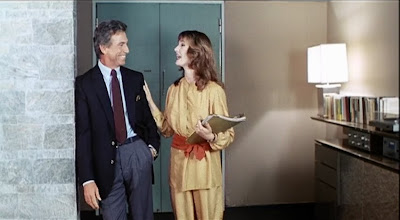
I’m still not sure, though. My appreciation of the film languished at a low-point throughout much of the film, rose unexpectedly to a fever-pitch of wow-that-was-awesome at the end but, with a day’s reflection, has returned to something middling really. It’s not that it’s not an awful lot of fun, it’s simply that it doesn’t cry out in quite the same way as something to be remembered. It doesn’t feel as gloriously unique as some of the others.
I should add, however, that whilst that assessment might be true of the film as a whole, there certainly were a few memorable moments. The extended scene in which a girl is chased by a dog (I really don’t want to give too much away) was Argento at his sublime best. No dialogue, just a building tension (carried wonderfully by Goblin’s score) that makes the scene almost painful to watch but impossible to turn away from. When Tenebrae gets it right, it gets it very right!
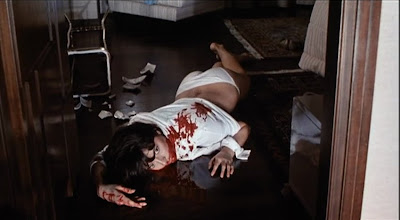
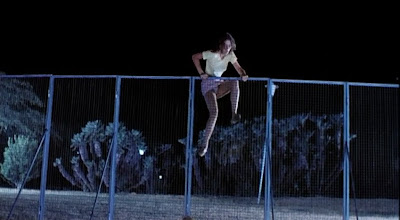
Tenebrae (AKA Tenebre)
Tonight’s film was Tenebrae, the first one that was new to me. Sadly, I’m way too tired to write about it now, so it can wait until the morning.
For now, fans of Justice’s ‘Phantom Parts I & II’ should probably check out the Tenebrae theme tune, contributed by repeated-Argento-collaborators, Goblin.
Justice:
Goblin:
Bird with the Crystal Plumage
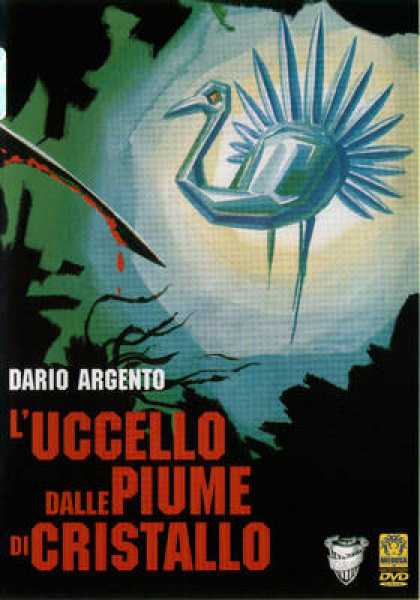
From one to the next!
Tonight’s film was Bird with the Crystal Plumage (L’uccello dalle Piume de Cristallo) which was another that I’d seen before but, once again, was none the worse for it.
My entry for this one will be much shorter. Mostly because I’m much more tired today, but partly also because the film is, in my eyes at least, somewhat less remarkable. It makes a fairly neat comparison against Opera though, mostly because nearly every flaw I found in Opera is corrected here.
Yesterday I pointed out that Opera’s music left something to be desired; here, a certain Mr Ennio Morricone steps in to create a score that bursts with energy when it needs to, broods menacingly at times and jangles its merry way through the film. Similarly, the actual plot - another weak spot in Opera - is phenomenally tight here. Mystery and suspense lurk at every set-piece and in ever shadow. I challenge any viewer not to spend the entire film guessing at who’s responsible for the series of grisly deaths handed out to the poor victims.
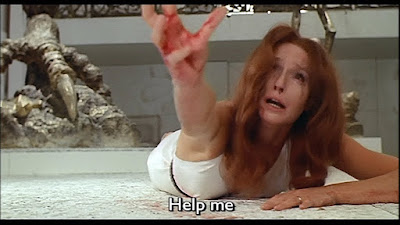

Yet, for all this, it simply doesn’t have the sheer atmosphere that makes Opera so thrilling. The camera, although rarely short of wonderful, doesn’t drag us, biting at our nails, into the story in the same way as yesterday’s film and this is telling of the film as a whole. It’s fascinating, it’s captivating, it’s beautiful but yet it never quite achieves the intensity of Opera.
If I’m damning it with faint praise, I must apologise. Bird with the Crystal Plumage is by no means a bad, or even mediocre film. It’s a great film. It tells a compelling story and it tells it very well indeed. But this is perhaps all it does; it is a brilliant story, but never quite manages to be a brilliant cinematic experience.
Note: It only occurred to me to check the date of this film as an afterthought. This is Argento’s first film as director, some 17 years before he directed Opera and perhaps this explains the points I highlight. This is a much more ’traditional’ film than Opera, a film that obeys more of the normal ‘rules’. In some respects, it’s the better for it, but in terms of a cinematic experience it merely hints at what he was to achieve later.
